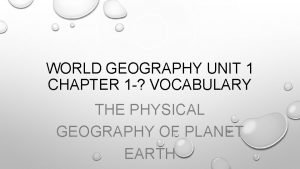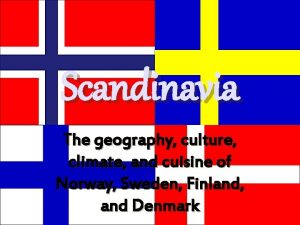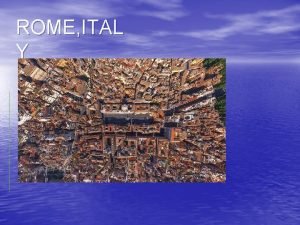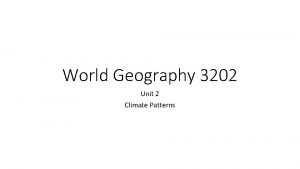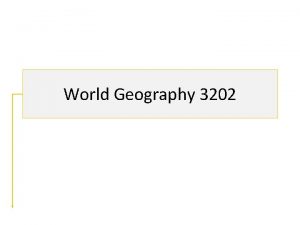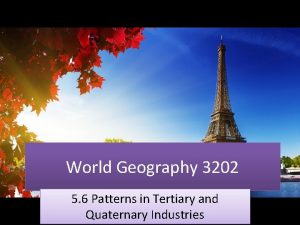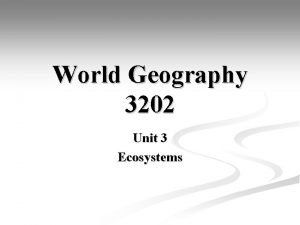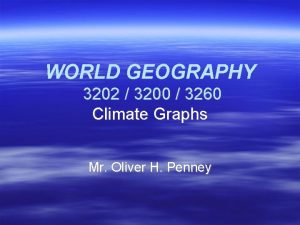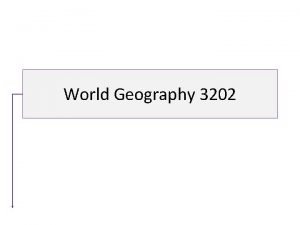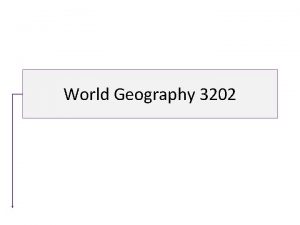World Geography 3202 Unit 2 Climate Patterns Introduction










- Slides: 10

World Geography 3202 Unit 2 Climate Patterns

Introduction § In this unit, we will examine some of the basic forces that produce our weather and climate, how they produce climate patterns on the earth’s surface, and relate to human activity. § These patterns are strongly affected by the distribution of landforms and water forms.

Weather and Climate: The earth, itself § The earth’s movement in space causes the occurrence of day and night. § It also causes the conditions related to the seasons. § When we refer to the rotation of the earth, we are referring to the 24 hour period it takes the earth to complete one full “spin” in orbit around the sun. – It is this 24 hour “spin” that causes the periods of day and night, as the sun shines only on the half of the earth that is pointed toward the sun.

Weather and Climate: The earth, itself § When we refer to the earth’s revolution, we are referring to the approximately 365 days that it takes the earth to revolve on it’s orbit around the sun. – This revolution is responsible for the seasons, as the portions of the earth that are more directly or less directly exposed to the sun’s rays will correspondingly experience different seasons.

Weather and Climate: The earth, itself Equinox: Refers to the period in the year when day and night are equal (12 hours long). This occurs twice a year, in March and September. Solstice: Refers to the period in the year when daylight is longest (or daylight is shortest) depending on the hemisphere: This occurs twice a year, in June and December

Solar Intensity The diagram above attempts to illustrate how the sun’s rays are dispersed as they strike the earth. The more direct the rays are, the more intense, and hence, more heat they give off. Where are temperatures generally going to be the warmest on the earth? Why?

Solar Intensity § temperatures tend to decrease from low to high latitudes. § Where might there be an exception to this rule at the equator (ie: There Are places at the equator that are extremely cold).

Solar inputs and outputs How cloud cover influences the range of temperatures from day to night. How the greenhouse effect moderates climates.

The cause of winds and how winds affect climate § Wind is the result of air movement over the Earth. § Air moves as a result of pressure systems from areas of high pressure to areas of low pressure.

Reasons for Pressure Variance § 1) The Earth rotates. As it rotates, it drags the atmosphere around with it causing the air to mix with the higher level atmosphere resulting in turbulence and pressure systems. § 2) The sun heats. The heating of air around the Earth varies by latitude and time of day. – At the equator, for instance, large amounts of sun warm the air causing it to rise. – Conversely, the more acute angles of sunlight over the polar regions spread the rays over a greater area resulting in less warming of the air. – The resulting effect is that the air over the poles is more dense than the air over the equator.
 World geography chapter 3 weather and climate
World geography chapter 3 weather and climate Climate change 2014 mitigation of climate change
Climate change 2014 mitigation of climate change World geography unit 9 lesson 1
World geography unit 9 lesson 1 World geography unit 1 test
World geography unit 1 test World geography unit 1 vocabulary
World geography unit 1 vocabulary Chapter 24 patterns of climate answer key
Chapter 24 patterns of climate answer key Scandinavian climate and geography
Scandinavian climate and geography Middle colonies climate/geography
Middle colonies climate/geography 13 colonies foldable
13 colonies foldable Iroquois geography and climate
Iroquois geography and climate Physical geography of rome
Physical geography of rome




